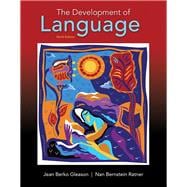Note: This is the bound book only and does not include access to the Enhanced Pearson eText. To order the Enhanced Pearson eText packaged with a bound book, use ISBN 013441201X.
Featuring a multi-disciplinary approach–and chapters written by outstanding scholars known for their expertise in the areas they discuss–The Development of Language focuses on language acquisition throughout the lifespan, with new coverage of linguistic achievements in the first year of life and through the middle school years. It examines what we know about language development using biological, social, and cultural contexts, while also investigating individual differences, atypical development, literacy, and language development in adults. Each chapter is written by world-renowned scholars and cutting-edge researchers, and each chapter provides a helpful summary, list of key words, a comprehensive text glossary explaining each term, and extensive links to video resources that help bring the concepts to clarity, through examples of child communication behaviors, insights into how research into child language is conducted, and first person interviews with influential researchers in the field.
The new edition emphasizes language development in children who are learning languages other than English or are bilingual and includes new information about children with risk factors for language delay or disorder. Within each topical area, such as speech production, vocabulary, syntax, pragmatics, and literacy, the authors integrate discussion of potential problems or differences in how children learn the various aspects of language. Cultural influences that lead to group and individual variation in children’s language environments and profiles of language development are addressed throughout. The Enhanced Pearson eText features embedded videos.
Improve mastery and retention with the Enhanced Pearson eText*
The Enhanced Pearson eText provides a rich, interactive learning environment designed to improve student mastery of content. The Enhanced Pearson eText is:
- Engaging. The new interactive, multimedia learning features were developed by the authors and other subject-matter experts to deepen and enrich the learning experience.
- Convenient. Enjoy instant online access from your computer or download the Pearson eText App to read on or offline on your iPad® and Android® tablet.*
-
Affordable. The Enhanced Pearson eText may be purchased stand-alone for 50-60% less than a print bound book.
* The Enhanced eText features are only available in the Pearson eText format. They are not available in third-party eTexts or downloads.
*The Pearson eText App is available on Google Play and in the App Store. It requires Android OS 3.1-4, a 7” or 10” tablet, or iPad iOS 5.0 or later.








